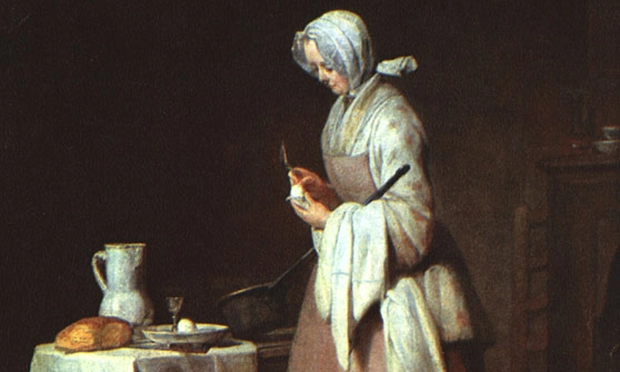Breaking Bread

The Attentive Nurse by Jean-Siméon Chardin. Image: Wikicommons
The straight back and weary lack of expression of this woman denotes a professional carer.
She is peeling a boiled egg with nonchalant skill, balancing in her left hand, already encumbered with a billowing kitchen cloth to hold the very hot egg, the long-handled, equally hot, saucepan in which they were cooked, while picking delicately at the shell of the egg in her right hand.
A bravura performance.
But couldn’t she have just dumped the pan on the table or shelf behind her, or on the floor along with the cooking pot at her feet, and attacked the egg unencumbered?
Anyone struggling to prepare hard-boiled eggs for a recipe can sympathise with her, and ignore the expert advice about the best way to proceed: eggs at room temperature, timing, plunging into cold water (the eggs, not the cook), and all the little wrinkles on offer when egg-peeling beecomes a competitive sport.
Chardin’s affection was all for the things on the little table rather than the human element. Simple domestic objects that he loved and to which he attached no double meaning, a welcome relief after the moralising in the still life paintings of Holland in the previous century. This is nourishing food for the old and sick.
Another peeled egg lies floppy in a bowl, along with a very small glass, which might have contained a nice restorative liquor, while the contents of the elegant white jug remain mysterious.
The bread, however, is the star of the picture. Its warm tones and rich texture occur over and over again in Chardin’s still lifes. You want to tear off a lump and enjoy the soft crumb and crispy crust, as one does the snack of bread and wine, sitting in its wrapping paper, in the National Galllery. It has been torn or broken, and if you attack an Italian panettone this way, you get better results than with a knife.
There was a time when good bread was hard to find. Many of us baked our own, inspired by Elizabeth David’s monumental English Bread and Yeast Cookery, and sought out honest flour from obscure producers. Sourdough was hardly mentioned in her book, getting much more renown in the USA.
How a bit of dough from your baking can be kept active until the next batch is one way among many of making bread with interesting flavours and textures, but today’s trendy sourdough is producing much grumpy lumpy stuff that is hardly edible – a blight on the expensive bread scene.
But after reading Rachel Roddy’s account in a recent copy of the Guardian of a perfectionist use of sourdough tecniques and ingredients, I nearly deleted the above paragraph. She is both erudite and funny, and describes how using special ingredients and tecniques, an enthusiast in Italy achieves remarkable bread leavening.
So the spirit of Chardin thrives in the Italian Marches, while ancient Roman hearth bread is made by Rachel in her modern Roman kitchen.
